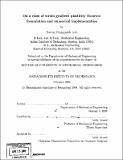On a class of strain gradient plasticity theories : formulation and numerical implementation
Author(s)
Lele, Suvrat Pratapsinh
DownloadFull printable version (15.52Mb)
Other Contributors
Massachusetts Institute of Technology. Dept. of Mechanical Engineering.
Advisor
Lallit Anand.
Terms of use
Metadata
Show full item recordAbstract
This study develops strain-gradient theories for isotropic and crystal plasticity. The following four theories were developed and numerically implemented: * A one-dimensional theory to understand the basic nature of strain gradient theories; * A small deformation crystal plasticity theory; * A small deformation theory for isotropic viscoplastic materials; and, * A large deformation theory for isotropic viscoplastic materials. The theories are based on: (i) microstresses consistent with microforce balances; (ii) a mechanical version of the two laws of thermodynamics for isothermal conditions, that includes via the microstresses the work performed during viscoplastic flow; and (iii) a thermodynamically consistent constitutive theory. The microscopic force balance, when augmented by constitutive relations for the microscopic stresses, results in a nonlocal flow rule in the form of a second-order partial differential equation for the plastic strain. The flow rule, being nonlocal, requires microscopic boundary conditions. The theories are numerically implemented by writing a user-element for a commercial finite element program. Using this numerical capability, the major characteristics of the theory are revealed by studying the standard problem of simple shear of a constrained plate. Additional boundary-value problems representing idealized two-dimensional models of grain-size-strengthening and dispersion-strengthening of metallic materials are also studied using the small deformation version of the isotropic theory. For problems that do not involve boundary conditions on plastic strain, the flow rule may be considered to be in conventional form, with additional strengthening terms, instead of a partial differential equation. The finite deformation version of the isotropic theory is numerically implemented by writing a user material model for this approach. Using this implementation, the problems of stabilization of widths of localization shear bands, strengthening in pure bending, and depth dependence of micro and nano-indentation hardness are studied.
Description
Thesis (Ph. D.)--Massachusetts Institute of Technology, Dept. of Mechanical Engineering, 2008. Includes bibliographical references (p. 247-251).
Date issued
2008Department
Massachusetts Institute of Technology. Department of Mechanical EngineeringPublisher
Massachusetts Institute of Technology
Keywords
Mechanical Engineering.